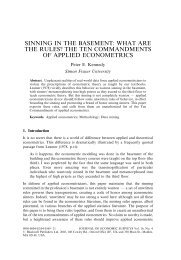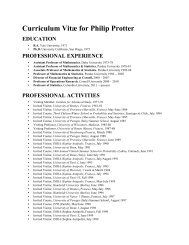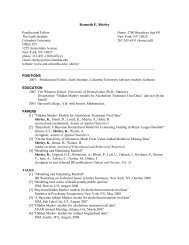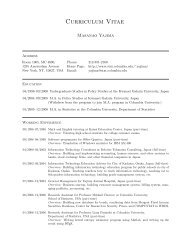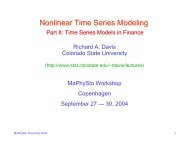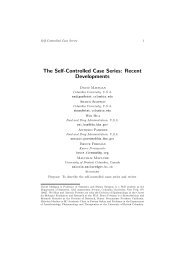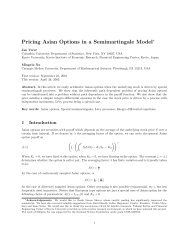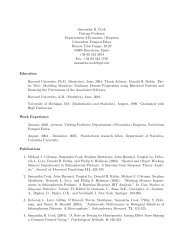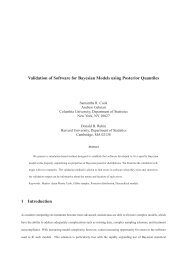Solution to selected problems.
Solution to selected problems.
Solution to selected problems.
Create successful ePaper yourself
Turn your PDF publications into a flip-book with our unique Google optimized e-Paper software.
15. If M 0 = 0 then by Theorem 42, there exists a Brownian motion B such that M t = B [M,M]t .<br />
By the law of iterated logarithm,<br />
lim<br />
t→∞<br />
M t B [M,M]t B τ<br />
= lim = lim<br />
[M, M] t t→∞ [M, M] t τ→∞ τ = 0<br />
If M 0 ≠ 0, Let X t = M t − M 0 . Then [X, X] t = [M, M] t − M 2 0 . So [X, X] t → ∞ and<br />
M t<br />
[M, M] t<br />
= X t + M 0<br />
[X, X] t + M 2 0<br />
→ 0<br />
17. Since integral is taken over [t − 1/n, t] and Y is adapted, Xt n is also an adapted process. For<br />
t > s ≥ 1/n such that |t − s| ≤ 1/n,<br />
∫ t ∫ t−1/n<br />
|Xt n − Xs n | = n<br />
Y τ dτ − Y τ dτ<br />
≤ 2n(t − s)<br />
∣ s<br />
s−1/n ∣ sup |Y τ |<br />
s− 1 n ≤τ≤t<br />
Since X is constant on [0, t] and [1, ∞), let π be a partition of [t, 1] and M = sup s−<br />
1<br />
n ≤τ≤t |Y τ | < ∞.<br />
Then for each n, <strong>to</strong>tal variation of X n is finite since<br />
sup |Xt n i+1<br />
− Xt n i<br />
| ≤ 2nM ∑<br />
π<br />
π<br />
(t i+1 − t i ) = 2nM(1 − t)<br />
Therefore X n is a finite variation process and in particular a semimartingale. By the fundamental<br />
theorem of calculus and continuity of Y , Y s = lim n→∞ n ∫ s<br />
s−1/n Y sdu = lim n→∞ Xt n for each t > 0.<br />
At t = 0, lim n X n = 0 = Y 0 . So X n → Y for all t ≥ 0. However Y need not be a semimartingale<br />
since Y t = (B t ) 1/3 where B t is a standard Brownian motion satisfies all requirements but not a<br />
semimartingale.<br />
18. B t has a continuous path almost surely. Fix ω such that B t (ω) is continuous. Then lim n→∞ Xt n (ω) =<br />
B t (ω) by Exercise 17. By Theorem 37, the solution of dZt<br />
n = Zs−dX n s n , Z 0 = 1 is<br />
= exp<br />
(X t n − 1 )<br />
2 [Xn , X n ] t = exp(Xt n ),<br />
Z n t<br />
since X n is a finite variation process. On the other hand, Z t = exp(B t − t/2) and<br />
lim<br />
n→∞ Zn t<br />
= exp(B t ) ≠ Z t<br />
19. A n is a clearly càdlàg and adapted. By periodicity and symmetry of triangular function,<br />
∫ π<br />
2<br />
0<br />
|dA n s | = 1 n<br />
∫ π<br />
2<br />
Since <strong>to</strong>tal variation is finite, A n t<br />
lim<br />
sup<br />
n→∞<br />
0≤t≤ π 2<br />
0<br />
|d sin(ns)| = 1 n · n ∫ π<br />
2n<br />
0<br />
d(sin(ns)) =<br />
∫ π<br />
2<br />
0<br />
d(sin(s)) = 1<br />
is a semimartingale. On the other hand,<br />
|A n t | = lim<br />
n→∞<br />
1<br />
n = 0 15



